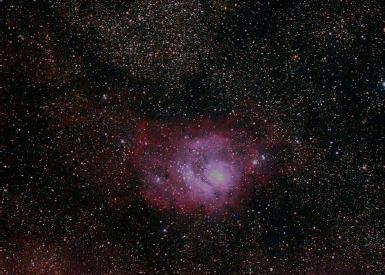LCAS Observer Challenge - September
Dave Wagner

Featured July/August Object - M8 Lagoon Nebula Lets wrap up the July/August challenge group with some info on a very observable object from the Messier list, M8, or the "Lagoon Nebula" pictured above. From a dark site the Lagoon Nebula is visible to the unaided eye, a large nebula with an embedded open cluster. With the aid of some magnification, Bok globules, small (actually 10,000 A.U. in size) dark knots of collapsing protostellar clouds are located across the nebula. Young hot stars are being born in the bright center. M8 is ionized by these stars, causing the gas clouds to glow. The open cluster, NGC6530 has 50 to 100 stars and is on the eastern side of the nebula.
As you cannot see all of these details in the photo above, please ask Steve to see the full photo he has of M8 with M20 (only 1.5 degrees away), or check out some of the photos on the web. Of course don't forget to include the Lagoon in your challenge list when it comes around again next summer. And it's worth the wait. Hope it rates a '5' in your observer report!
Observer Challenge for Sept/October
As we head into the last month of summer, the days get shorter... but to an astronomy buff, simple math gives us a reason to smile (24 hrs - shorter days = LONGER NIGHTS!). With a little cooperation from the weather, you'll have more time (or at least get to bed a little earlier) to take on some fine Observer Challenge objects, and there are a few that may be a real challenge. The Sep/Oct Messier list block is a short list, so one could readily complete both year one and year two lists if that is your personal challenge. Or perhaps you've just accepted the challenge? Well this is a great month to get started, with a very manageable Messier collection. On the high end of the challenge scale will be NGC253 (Sculptor or Silver Coin Galaxy) and NGC 7293 (Giant Helix Nebula).
The galaxy NGC253 is the brightest of the Sculptor group of galaxies, which is grouped around the South galactic pole. This group is perhaps the nearest to our Local Group of galaxies. NGC 253 is also one of the brightest galaxies beyond the Local Group; however its low position in the sky at our latitude will make it a bit more elusive.
NGC7293 may be the largest planetary nebula, and at 300 to 500 light years, is the closest to Earth. It is about 1/2 the size of a full moon. Sounds like it should be easy to find, but despite its large size and close proximity, it will be a challenge with its low surface brightness. An OIII or UHC filter may help to show details.
Good luck, Challenge Observers! Be sure to also record your ratings per the scale on the challenge list and on the observer forms. I'll be collecting just your ratings later this year (even if you have not finished a block) to get a flavor on how LCAS members rank these objects. If you have favorites you want to add to the lists, let me know. If you haven't gotten started, this is the month!





